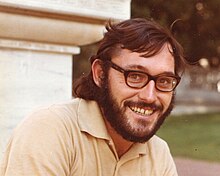Loading AI tools
American mathematician From Wikipedia, the free encyclopedia
Robert Luke Devaney (born 1948) is an American mathematician. He is the Feld Family Professor of Teaching Excellence at Boston University, and served as the president of the Mathematical Association of America from 2013 to 2015. His research involves dynamical systems and fractals.[1]
Robert L. Devaney | |
|---|---|
 Devaney in 1973 | |
| Born | April 9, 1948 Lawrence, Massachusetts, U.S. |
| Alma mater | College of the Holy Cross (BA) University of California, Berkeley (PhD) |
| Scientific career | |
| Fields | |
| Institutions | Northwestern University Tufts University Boston University |
| Thesis | Reversible diffeomorphisms and flows (1973) |
| Doctoral advisor | Stephen Smale |
| President of the Mathematical Association of America | |
| In office 2013–2015 | |
| Preceded by | Paul M. Zorn |
| Succeeded by | Francis Su |
Devaney was born on April 9, 1948, in Lawrence, Massachusetts.[2] He grew up in Methuen, Massachusetts.[3]
Devaney graduated in 1969 from the College of the Holy Cross,[4][5] and earned his Ph.D. in 1973 from the University of California, Berkeley, under the supervision of Stephen Smale.[6][7] From 1974 to 1976, he was a postdoctoral research fellow at Northwestern University.[2] Before joining the faculty at Boston University, he taught at Tufts University, Northwestern University, and the University of Maryland, College Park.[4][5]
Devaney is known for formulating a simple and widely used definition of chaotic systems, one that does not need advanced concepts such as measure theory.[8] In his 1989 book An Introduction to Chaotic Dynamical Systems, Devaney defined a system to be chaotic if it has sensitive dependence on initial conditions, it is topologically transitive (for any two open sets, some points from one set will eventually hit the other set), and its periodic orbits form a dense set.[9] Later, it was observed that this definition is redundant: sensitive dependence on initial conditions follows automatically as a mathematical consequence of the other two properties.[10]
Devaney hairs, a fractal structure in certain Julia sets, are named after Devaney, who was the first to investigate them.[3][11]
As well as research and teaching in mathematics, Devaney's mathematical activities have included organizing one-day immersion programs in mathematics for thousands of Boston-area high school students, and consulting on the mathematics behind media productions including the 2008 film 21 and the 1993 play Arcadia.[1][3] He was president of the Mathematical Association of America from 2013 to 2015.[4][5]
In 1995, Devaney won the Deborah and Franklin Tepper Haimo Award for Distinguished University Teaching of the Mathematical Association of America.[12] In 2002 Devaney won the National Science Foundation Director's Award for Distinguished Teaching Scholars.[1][13] He was named the inaugural Feld Professor in 2010.[1]
In 2008, a conference in honor of Devaney's 60th birthday was held in Tossa de Mar, Spain. The papers from the conference were published in a special issue of the Journal of Difference Equations and Applications in 2010, also honoring Devaney.[3]
In 2012 he became one of the inaugural fellows of the American Mathematical Society.[14]
Devaney is the author of books on fractals and dynamical systems including:
Some of the more highly cited of Devaney's research publications include:
Seamless Wikipedia browsing. On steroids.
Every time you click a link to Wikipedia, Wiktionary or Wikiquote in your browser's search results, it will show the modern Wikiwand interface.
Wikiwand extension is a five stars, simple, with minimum permission required to keep your browsing private, safe and transparent.